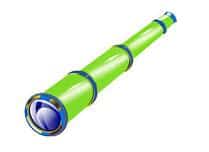A spotting scope is a portable optical tool that can be extended according to the user's need. It is a type of monocular glasses : a tube with a lens at the end that increases the size of images of things located far away.
 It is believed that the inventor of the spyglass was the German Hans Lippershey (1570-1619), who based on theoretical developments by other scientists to build the first telescope of practical use. Lippershey , however, did not obtain a patent for the invention . Based on the work of the German, Galileo Galilei finally managed to improve the telescope (which is an instrument equipped with mirrors or lenses to enlarge the image of an element located at a great distance).
It is believed that the inventor of the spyglass was the German Hans Lippershey (1570-1619), who based on theoretical developments by other scientists to build the first telescope of practical use. Lippershey , however, did not obtain a patent for the invention . Based on the work of the German, Galileo Galilei finally managed to improve the telescope (which is an instrument equipped with mirrors or lenses to enlarge the image of an element located at a great distance).
The first spyglasses were used by naturalists to observe species and by sailors to try to sight land. Over time they began to be used in other observations, even in the field of astronomy.
In addition to the above, we cannot ignore that there are fundamentally two types of spyglasses:
-Roof spyglasses. They also respond to the name linear and receive this name because they have linear prisms and objective lenses. They have the advantage that due to their size and weight they are very practical to take on a trip as part of your luggage. And they are great when, for example, taking trips to discover the beauty of different natural places.
-The joint spotting scopes, which have the peculiarity that they use what are triangular lenses. They offer a non-linear vision. Unlike the first, they are much heavier and need to be used using a tripod . Given these characteristics and many others, it should be noted that they become the best option to enjoy a panoramic view of great distances. In the same way, this type of spyglass is ideal for carrying out astronomical observations.
The main characteristics of spotting scopes are their diameter and their degree of magnification . Larger diameter lenses allow more light to be captured and, thus, offer brighter images. The degree of magnification, for its part, alludes to the zoom possibilities offered by the spyglass. Generally this degree is mentioned by a multiplier, such as 10x or 20x .
When purchasing a spotting scope, three significant aspects must be taken into account:
-The use that is going to be given to it. And based on the job you want to be given, you will have to choose to buy one type or another.
-The diameter of your lens, since the larger it is, it will capture more light and, therefore, will allow you to obtain a much brighter image.
-The degree of magnification it offers because this way you can have some images or others with more details and proximity.
Nowadays, the use of spyglasses transcends the field of science . In many tourist sites, spyglasses are installed so that visitors can enjoy panoramic views or try to spot animals that, with the naked eye, are difficult to detect.
